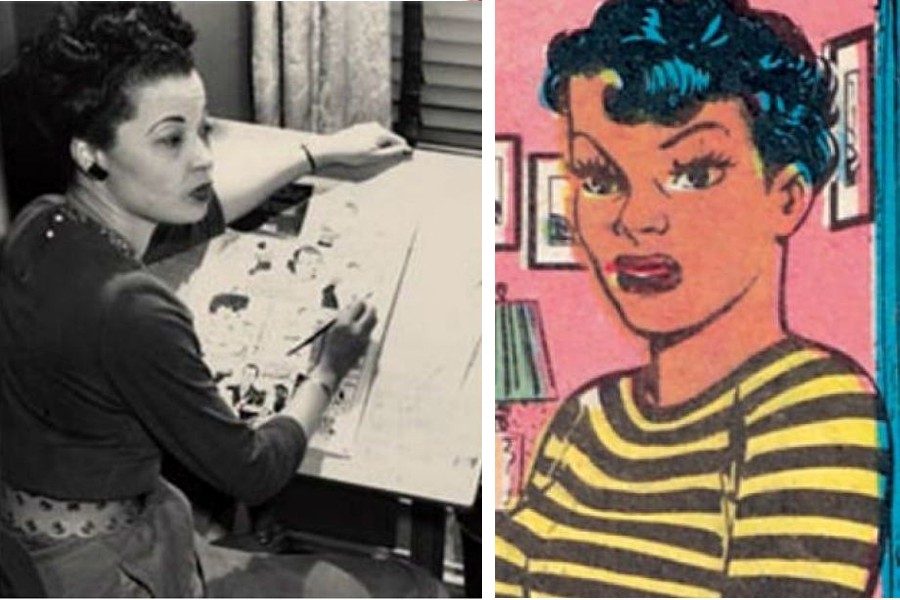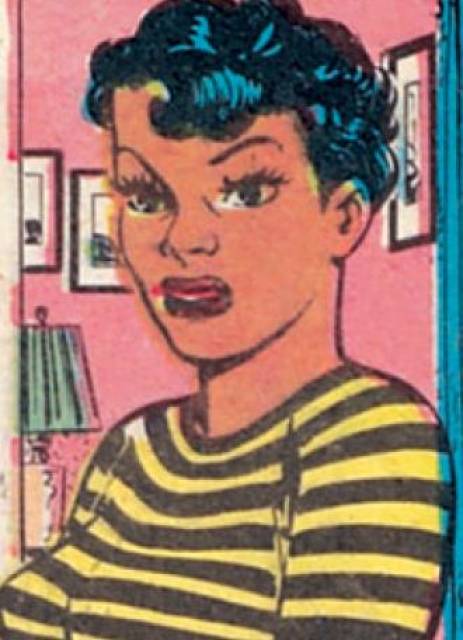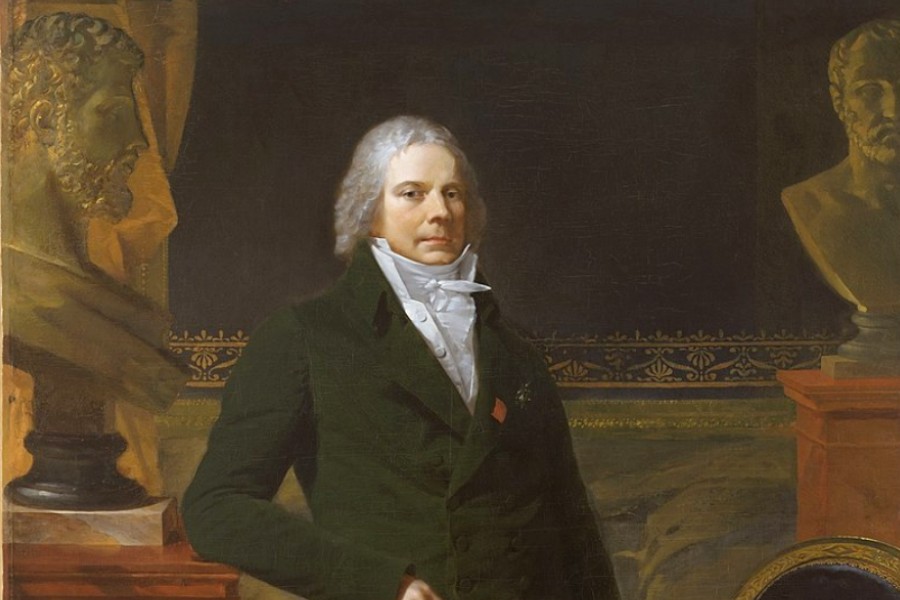Jackie Ormes, August 1, 1911 – December 26, 1985, is known as the first African-American woman cartoonist and creator of the Torchy Brown comic strip and the Patty-Jo ‘n’ Ginger panel.
Jackie Ormes was born Zelda Mavin Jackson on August 1, 1911 in Pittsburgh, Pennsylvania, to parents William Winfield Jackson and Mary Brown Jackson. Her father William, the owner of a printing company and movie theater proprietor, was killed in an automobile accident in 1917. This resulted in the then six-year old Jackie and her younger sister Dolores in the care of their aunt and uncle for a brief period of time. Eventually, Jackie’s mother remarried and the family relocated to the nearby suburb of Monongahela. Ormes described the suburb in a 1985 interview for the Chicago Reader as “spread out and simple. Nothing momentous ever happens here”. She graduated from high school in Monongahela in 1930.
Ormes drew and wrote throughout high school. It was during this period that she wrote a letter to the editor of the Pittsburgh Courier, a weekly African-American newspaper that was published on Saturdays. The then-editor, Robert Van, wrote back. This correspondence led to her first writing assignment- covering a boxing match. Her coverage of future matches led her becoming an avid fan of the sport.
Ormes started in journalism as a proofreader for the Pittsburgh Courier. She also worked as an editor and as a freelance writer, writing on police beats, court cases and human interests topics. While she enjoyed “a great career running around town, looking into everything the law would allow, and writing about it”, what she really wanted to do was draw.
Ormes’s first comic strip, Torchy Brown in Dixie to Harlem, first appeared in the Pittsburgh Courier in 1937. In addition to the Courier, Torchy Brown was syndicated to fourteen other black newspapers. The strip,starring Torchy Brown, was a humorous depiction of a Mississippi teen who found fame and fortune singing and dancing in the Cotton Club.
Torchy’s journey from Mississippi to New York City mirrored the journey of many African-Americans who ventured northward during the Great Migration. It was through Torchy Brown that Ormes became the first African-American woman to produce a syndicated comic strip. The strip would run until 1940. The reason for the strip’s abrupt end is uncertain, but it is presumed to be due to an end in her contract.
Ormes moved to Chicago in 1942, and soon began writing occasional articles and, briefly, a social column for The Chicago Defender, one of the nation’s leading black newspapers, a weekly at that time. For a few months at the end of the war, her single-panel cartoon, Candy, about an attractive and wisecracking housemaid, appeared in The Defender.
By August 1945, Ormes’s work was back in the Courier, with the advent of Patty-Jo ‘n’ Ginger, a single-panel cartoon that ran for 11 years. It featured a big sister-little sister set-up, with the precocious, insightful, and socially/politically-aware child as the only speaker and the beautiful adult woman as a sometime pin-up figure and fashion mannequin.
In 1950, the Courier began an eight-page color comics insert, where Ormes re-invented her Torchy character in a new comic strip, Torchy in Heartbeats. This Torchy was a beautiful, independent woman who found adventure while seeking true love. Ormes expressed her talent for fashion design as well as her vision of a beautiful black female body in the accompanying Torchy Togs paper doll cutouts.
The strip is probably best known for its last episode in 1954 when Torchy and her doctor boyfriend confront racism and environmental pollution. Ormes used Torchy in Heartbeats as a sounding board for several big issues of the time. In a 1985 interview for Chicago Reader, she claimed she was ” anti-war-I was anti-everything-that’s-smelly”. Torchy presented an image of a black woman who, in contrast to the contemporary stereotypical media portrayals, was confident, intelligent, and brave.
Ormes contracted with the Terri Lee doll company in 1947 to produce a play doll based on her little girl cartoon character. The Patty-Jo doll was on the shelves in time for Christmas and was the first American black doll to have an extensive upscale wardrobe. As in the cartoon, the doll represented a real child, in contrast to the majority of dolls that were mammy and Topsy-type dolls.
The dolls were popular with both black and white children. In December 1949, Ormes’s contract with the Terri Lee company was not renewed, and production ended. Patty-Jo dolls are now highly sought collector’ items.
What makes Ormes so extraordinary is that not only did she break past the expected roles as a woman and as an African American in the 20th century, but she did so with the rich content of her work. Her heroines, like the iconic Torchy Brown, Candy, and Patty Jo ‘n’ Ginger, all ignored the heinous, albeit expected, stereotypical look and actions of a black woman in media (fat, slow, dumb, ungraceful etc).
Orme’s characters are strong and independent women who are socially and politically aware, who strive for their goals against all odds, defy social norms, and pick themselves up by the bootstraps and move on to the next adventure, instead of languishing in their downfalls. In an interview towards the end of her life Ormes said, “I have never liked dreamy little women who can’t hold their own.” Orme’s creations not only defied expectations for black women, but gave her readership strong models for what the next powerful generation of young black women could become.
Jackie Orme’s heroines faced challenges that did not face dragons or evil stepmothers, but instead faced relatable and contemporary issues; smothering aunts and the dangers of being taken advantage of in an unfamiliar environment, to name a few. While this artist generated a fanciful career path for Torchy Brown, the young performer’s tale is woven with seeds of reality. Torchy faced deception, unsympathetic peers, racism, danger, and heartbreak- but no matter the odds she came through. Orme’s created women that her readership could believe in, root for, and aspire to be.
Ormes tackled social and political issues everywhere from race to sex to environmental pollution. In each aspect of her life the cartoonist was involved in humanitarian causes, and her passion in very left-wing ideologies post-World War II even led to an investigation by the FBI.
Writer/producer Susan Reib has strived for more than 20 years to bring Jackie Orme’s historic contributions to the development of American comics and the role of female African Americans in them back to the attention of the public. Jackie Ormes created a character that could step into a world that was forbidden to her. She gave voice to a whole generation of readers. I feel that her voice is as potent today as when she first put pen to paper. The issues of racism sexism and even environmental pollution, against the backdrop of romance, were being tackled. She took these issues on before they were popular.” As a creative filmmaker, the story is that Jackie created a character that comes to life and empowers her to face her own life…”
Jackie Ormes married accountant Earl Ormes in 1936. The couple initially moved to Salem, Ohio so Earl could be close to his family. But Ormes was not happy there, and they eventually moved back to Chicago. The pair had one child, Jaqueline, who died of a brain aneurysm at the age of three. Ormes would remain married to Earl until his death in 1976.
She retired from cartooning in 1956, although she continued to create art, including murals, still lifes and portraits until rheumatoid arthritis made this impossible. She contributed to her South Side Chicago community by volunteering to produce fundraiser fashion shows and entertainments. She was also on the founding board of directors for the DuSable Museum of African American History. Ormes was a passionate doll collector, with 150 antique and modern dolls in her collection, and she was active in Guys and Gals Funtastique Doll Club, a United Federation of Doll Clubs chapter in Chicago. She died of a cerebral hemorrhage in Chicago on December 26, 1985. Ormes was posthumously inducted into the National Association of Black Journalists Hall of Fame in 2014.
In 2018 she was inducted into the Eisner Hall of Fame.
Photo credit: 1) source. 2) ComicsBeat. 3) SOurce.
Become a Harlem Insider!
By submitting this form, you are consenting to receive marketing emails from: . You can revoke your consent to receive emails at any time by using the SafeUnsubscribe® link, found at the bottom of every email. Emails are serviced by Constant Contact











